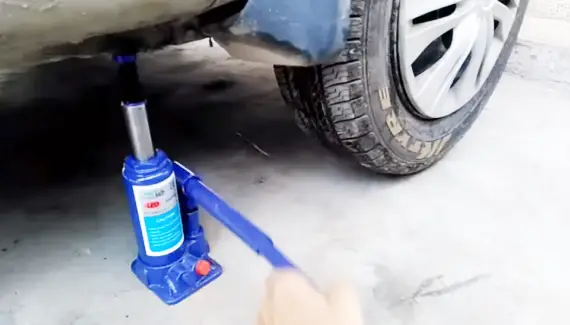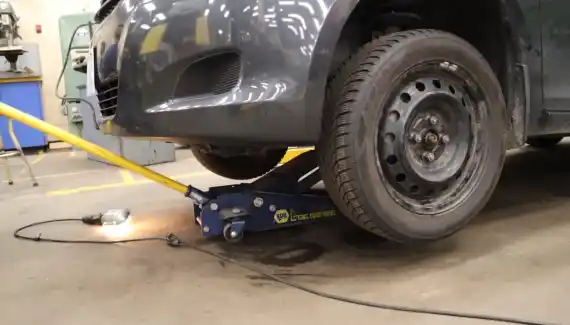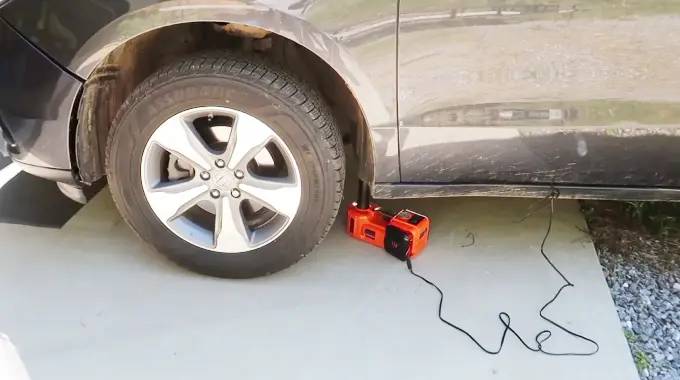Last Updated on June 3, 2023
Are you looking for an efficient and powerful way to lift your car to make repairs or maintenance? Hydraulic car jacks might be the right choice, but are they safe to use? After all, if something goes wrong while using a hydraulic car jack, it can cause severe injury or even death.
Naturally, you’re concerned about your safety, as well as the safety of your vehicle. Rest assured, a hydraulic car jack can be an effective tool for automotive maintenance when used correctly and carefully inspected for signs of wear and damage.
Today we will look at what makes a hydraulic car jack safe and what safety precautions one must take. We will also look at how to tell if a jack is in working condition and what maintenance is required. So let’s dive in and learn more about the safety of using a hydraulic car jack.
How Can You Trust a Hydraulic Car Jack When Lifting a Car?

Hydraulic car jacks are essential for safely and securely lifting and stabilizing cars for an auto repair, changing flat tires, or other maintenance. But before trusting a hydraulic car jack to your car, it is critical to understand the different types of car jacks available, their capacity, weight limitations, and proper use instructions.
Always check the product label or instruction manual when lifting a car with a hydraulic car jack. This will help you to confirm the jack is rated for the weight of your car. Also, ensure the jack has no visible defects before using it, like worn parts or cracked frames.
For maximum safety, place the hydraulic floor jack on a level surface when working with a car. Work three feet away from combustible materials so sparks don’t ignite leaking fuel vapor. Once the jack is positioned correctly, push down with both hands and release quickly to test its stability.
Also, use additional safety measures like chock blocks whenever possible. Adding additional support, like a leveled block of wood underneath the tire, will ensure stability when lifting an unevenly weighted load or only making repairs on one side.
Always exercise caution when working with jacks under vehicles due to moving parts, sharp edges, hazardous chemicals, and extreme temperatures near gasoline tanks, brakes lines, and suspension systems that may be located under cars.
Potential Dangers of Working Under a Bottle Jack-Supported Car
Working on a bottle jack-held car might raise some eyebrows, but you’re sure to want to know what kind of dangers lurk beneath the hood.
From slipping jacks and overturned cars, there’s no shortage of hazards that could put your safety at risk, but knowing them is key to keeping yourself safe.
1. Unstable/Unlevel Positioning of the Vehicle
When jacking up a car with a bottle jack, it can be dangerous to work underneath, as the vehicle can topple over if it is unlevel or unstable. A slight misalignment or imbalance can cause the car jack to become unstable.
The weight could suddenly shift and crush anything underneath. It is dangerous to try and use a jack when you are on an uneven surface, as it can be harder to keep the jack balanced.
2. Mechanical Failure of the Jack
The primary function of a bottle jack is to safely lift and support a heavy load such as a car. Still, mechanical failure due to overuse or improper use can cause severe injury or death if someone happens to be standing beneath it.
Over time, deterioration can cause corrosion of certain parts within the jack, which leads to an inability to hold up weight securely. Also, using an improper size jack for your specific job can cause significant damage due to excessive strain on its components.
3. Inadequate Lifting Capacity/Height Range Limitations
Bottle jacks can only lift and go up to a certain weight and height. If you try to lift something heavier or make it go higher than it should, the jack stand may break and cause someone to get hurt.
Also, attempting to use a bottle jack for purposes other than what it was designed for can result in serious safety hazards such as malfunctioning or complete breakdowns of its internal parts.
4. Slippage or Leakage of the Jack
Slippage and leakage issues with bottle jacks can also serve as potential risks when working underneath cars. If there is any kind of breach in its hydraulic system due to deterioration over time, oil can leak out, causing it to fail during operation without any warning signs.
Aspects like improper leveling on uneven surfaces may also cause slippage, leading to vehicle instability while being lifted up. Both the user and the people around them could be in danger.
All this combined makes staying aware of any possible signs of leakage or slippage absolutely essential before attempting any repair work underneath a supported car with a bottle jack.
How to Tell If a Hydraulic Car Jack is in Working Condition?
When jacks aren’t inspected and maintained, they get rusted or stuck and can even cause serious injury if they suddenly break during use. Taking the time to assess these tools can help keep your jack working correctly and safely.
The first step when determining the working condition of a hydraulic car jack is to check it for any visible defects, such as:
- Cracks in the frame
- Damaged components
- Loose nuts and bolts
- Worn parts
Check the outside and underneath of the jack for oil leaks from punctured hoses or bad seals.
It can also be helpful to move all the mechanisms on the jack through their entire range of motion, like adjusting its handle height or releasing its hold button any locking or sticking issues that could indicate damage inside its interior mechanisms.
Also, inspect the whole lifting shaft of your hydraulic car bottle jack, including:
- Release valve control knob
- Lifting arm extension lever
- Treadle pump handle
It will ensure they are all in working condition before use. Try to use several pumps and fully extended arms to slowly raise a load and quickly lower the load on shorter strokes from a higher height.
Finally, test out both settings on your jack, the pressure relief setting and maximum lift capacity, to maintain its fluidity between pumps without losing speed during normal use due to air bubbles trapped within its lines.
What Must You Do Before You Go Under a Car Supported By a Bottle Jack?
After reviewing the potential dangers above, safety should be your primary concern when working in this situation. Here are a few steps you should take before going beneath any bottle jack-supported car:
1. Use Axle Stands
Before going under a car raised with a bottle jack, it is essential first to ensure axle stands are used. Axle stands to help support the weight of the car, allowing for safe and secure work underneath the vehicle.
All four corners of the car must be securely held with axle stands and checked for any instability before anyone goes underneath. The axle stands should also be made from robust high-grade materials and must be rated to support the car’s weight.
They should be placed on an even surface and locked into position using their appropriate locking mechanisms.
2. Use the Appropriate Size and Type of Bottle Jack
When selecting a bottle jack for use under a car, it is essential to select an appropriate size and type for the job. Bottle jacks vary in size, so it is important to choose one that can safely handle the weight of the vehicle it will be used with.
Some bottle jacks are designed specifically for lifting cars, while others may be more suited towards other tasks such as removing wheels or replacing bearings.
So it is necessary to properly assess which type of jack best suits the task at hand before proceeding further.
3. Check That No Oil Leaks
Before working on a vehicle supported via a bottle jack, it is critical to check that no oil leaks exist. This can be done by carefully examining both the jack itself and its connection points on the car where applicable.
If any fluid or residue is present at either point, then this could signify an underlying issue that may need further investigation before proceeding with any repairs or maintenance work underneath the vehicle.
4. Verify That the Ground Is Level
Before getting underneath a bottle jack-supported car, it is also essential to make sure that the ground beneath is level. When you lift the load from its axles using the jack, this will affect how evenly distributed and secure the load is.
Whenever possible, you should position your axle stands on flat surfaces like concrete or hard-standing areas. That way, they won’t sink into the softer ground and become unstable while in use. It’s a great way to stay safe when working on your car.
5. Always Double Check All Connections
Before going under a car that is on a bottle jack, take the time to double-check all connections.
This means making sure that the jack is properly connected to both the car’s frame and the floor, as well as ensuring that all other parts of the structure are tightly secured.
Any stabilizer or wheel chock should also be checked for proper placement and security before proceeding. In case the space where you’re working on the vehicle isn’t level or secure, take further precautions.
6. Block the Wheels
It’s important to block the wheels of a bottle jack-supported car using wheel chocks, blocks, or other heavy objects. Place these securely in front and behind each tire to prevent any unexpected rolling off the jack while you’re working underneath.
Ensure that these items are wedged firmly against both tires simultaneously for maximum effectiveness and stability. Once the wheel blocks are in place, make sure they stay put. Moving them while you’re working can create an unsafe situation.
7. Keep Your Hands And Arms Clear of Any Moving Parts
When adjusting a bottle jack, especially when supporting an automobile, it’s imperative to avoid touching anything moving at all times.
It’s important to remember that although a bottle jack may appear sturdy enough to hold up your vehicle safely when used correctly.
Unexpected events like slipping gears or over-inflated pressure can quickly cause it to become unstable and potentially dangerous if you are too close.
To prevent injury due to potential accidents whilst working with a bottle hydraulic jack, always make sure your hands and arms are out of reach from all moving parts before making adjustments or raising/lowering your vehicle with the device.
8. Never Work Under the Car Alone
Working under an automobile supported by a bottle jack should never be done alone, even if you have taken all the safety precautions listed above.
Having someone present who can help you if something goes wrong is invaluable in this situation.
You must also never attempt this task if you feel tired or unwell since fatigue can significantly impair judgment and increase risk-taking behavior, which could lead directly to accidents. Instead, wait until you feel rested before attempting any tasks underneath the car.
How Can You Safely Use a Hydraulic Car Jack to Lift a Car?

Whether changing the car engine oil or checking out a suspected mechanical problem, you’ll need to lift the car off the ground with a hydraulic car jack. Check out these steps before, during, and after lifting your car:
Step 1. Gather Your Supplies
Before you attempt to use any type of vehicle lift, make sure you have all of the necessary supplies on hand. At a minimum, this includes:
- Hydraulic car jack (with the appropriate length for the vehicle),
- A lug wrench,
- Floor jacks (if needed),
- Jack stands and wheel chocks.
Ensure everything is in good condition before attempting any work under your car.
Step 2. Place & Prepare Your Vehicle
Before lifting your vehicle up with a hydraulic car jack, park your car in a level spot on a solid and even surface. Once that’s done, set the emergency brake so the car will not move. Now place wheel chocks on both sides of one of the wheels (this will prevent unwanted movement while working).
Step 3. Ready Your Jack
Place your jack in an appropriate spot underneath your vehicle following manufacturer instructions and ensure it’s secure. You don’t want it moving around unexpectedly once you start raising it.
Make sure steel parts are not touching any body panels or exhaust pipes. They can cause significant damage when heated up from regular operation or in contact with other engine bay components, like alternators or turbochargers.
Step 4. Lift Your Vehicle
If everything is right, start pumping your hydraulic bottle jack handle until the desired height is reached (use caution, going too high can be dangerous).
Once at the desired height, set safety stands at either side of the vehicle and lower onto these scissor jack stands before taking your hands off the handle/pump area of the jack (never rely solely on stands before doing this step).
Step 5. Release Pressure & Lower Jack
With weight securely supported by safety stands, release pressure from the handle/pump area by pushing the red knob forward. Never manually lower the arm without first releasing pressure (doing so could result in severe injury or damage).
You should see pressure slowly released from the jack as it lowers back down. When fully lowered, secure the latch into place per manufacturer instructions, as well as remove any chocks before crawling around underneath for maintenance or inspection purposes.
How Long Can You Leave a Car on a Hydraulic Car Jack?

The time you can leave your vehicle on a hydraulic car jack depends on several factors, including the type of vehicle and lift. Generally speaking, it is not recommended to leave a vehicle on a hydraulic car jack for more than an hour, as the constantly transferring weight may cause the jack to fail.
Also, leaving the vehicle jacked up for extended periods can cause damage to other components like tires or suspension pieces. Using safety scissor jack stands along with your hydraulic car jack will provide added stability and support while you make repairs or inspect underneath your car.
What are the Advantages and Disadvantages of Hydraulic Car Jack?
A hydraulic car jack’s powerful and reliable lifting capabilities can significantly add to anyone’s garage or toolbox. But, as with any equipment, you should consider the pros and cons before investing in a hydraulic jack.
Advantages of Using a Hydraulic Car Jack:
- High Lifting Capacity: Hydraulic jacks typically have much higher lifting capacity than other jacks, making them suitable for lifting heavier vehicles.
- Stable & Safe: A hydraulic car jack tends to be more stable and secure than other types due to its locking mechanism and broad base for stability during operation.
- Efficient & Versatile: Hydraulic car jacks are efficient since you only need to pump the handle once for each complete lift cycle, and they work on all kinds of vehicles, such as cars, vans, SUVs, trucks, etc.
- Compact & Portable: These tools tend to be compact, so they’re easy to store away when not in use and lightweight enough to carry around easily if needed.
Disadvantages of Using a Hydraulic Car Jack:
- Expensive Price Tag: Compared to other types of jacks, hydraulic jacks often come with an expensive price tag which may put some people off from investing in one for themselves.
- Time-Consuming Setup: You’ll have to be patient when setting up a hydraulic car jack since it’s a bit more involved than other jacks that must fit under the car before pumping the handle.
- Limited Usefulness: Although these tools are awesome for mechanical things like changing tires or making major vehicle repairs, you can’t use them for smaller stuff like changing light bulbs.
Does a Hydraulic Car Jack Wear Out Over Time?

Generally speaking, hydraulic car jacks last for many years with proper maintenance and use. But frequent and improper use can cause wear and tear on the jack over time which could shorten its lifespan.
Inspecting the car’s hydraulic jack can help identify potential problems early on so they can be addressed before they cause more severe damage or even render the jack unusable.
What Maintenance is Required for a Hydraulic Car Jack?
- Lubricate the metal surfaces of the jack with a quality lubricant designed for metal surfaces, such as WD-40.
- Check for leaks in the hydraulic fluid lines; if found, replace them accordingly.
- Make sure to regularly tighten loose bolts or nuts and inspect the entire unit for signs of wear or damage.
- When not in use, keep any removable parts (e.g., levers) stored safely in their proper place and check periodically that they are tight and secure.
- Keep your hydraulic car jack clean at all times. A brush and cloth can gently remove the dirt accumulated over time.
- If using an extension handle, ensure it is always attached securely before raising and lowering any heavy load with your hydraulic jack.
- Never extend beyond the handle’s maximum length setting when doing so.
- Make sure you store your hydraulic car jack in a dry place that won’t get damaged by dust, moisture, and other environmental factors.
Can Hydraulic Car Jacks Fail?
Hydraulic car jacks can fail when overloaded by attempting to lift a heavy object that is too heavy for the jack. It can cause the jack to stop working and potentially collapse. Also, old and faulty jacks can experience failure due to age or lack of proper maintenance.
Even with regular maintenance, some parts of the jack may need to be replaced occasionally for it to remain functional. If any of these issues are neglected, then the chances of experiencing a failure increase significantly.
What is the Biggest Safety Risk in a Hydraulic Car Jack?
The biggest safety risk in using a hydraulic car jack is attempting to lift an object that exceeds its rated capacity. Doing so will put an excessive amount of strain on the system. A sudden collapse could result in injury or death if someone stands near or underneath it.
For this reason, it’s essential to use a hydraulic car jack for lifting objects within its designed capacity, as indicated by its manufacturer’s instructions. Also, maintain the jack properly and replace faulty parts before use to ensure optimal performance and safety.
What are the Safety Precautions When Using a Hydraulic Car Jack?

When operating a hydraulic car jack, it is essential to consider safety precautions:
- You should always check the load capacity of the hydraulic car jack.
- Do not walk or crawl under hydraulic jacks. This can be extremely dangerous.
- Ensure maximum efficiency and safety by changing your oil regularly.
- Use the jack point on your vehicle when you use a hydraulic car jack to increase stability and reduce the risk of accidents.
Remember that if you follow these precautions every time you use a hydraulic jack, it can help prevent any potential accidents or mishaps from occurring.
Where Is the Best Place to Put a Bottle Jack Under a Car?
Bottle jacks work best underneath the car’s rocker panels. These reinforced metal ribs are specifically designed to bear the vehicle’s weight and safely lift it up without causing any damage.
When lifting, it is important to be mindful of where the jack is positioned in relation to the jack point. Ideally, it should be placed just behind the front wheels and just ahead of the rear wheels for optimal stability.
If you exceed your jack’s maximum load rating, you risk damaging your vehicle or, worse, injuring yourself.
How Much Weight Can a Bottle Jack Lift?
Hydraulic bottle jacks can typically lift loads ranging from 2 to 20 tons, whereas industrial bottle jacks have a much higher capacity of up to 100 tons.
It is important to note that depending on their design and construction materials, exact load capacities may vary from one model to another so it is always important to check manufacturer specifications before attempting any lift.
Make Vehicle Maintenance Easier with a Hydraulic Car Jack
Hydraulic car jacks can be extremely useful tools that allow you to perform maintenance on your vehicle quickly. However, you must use them carefully to avoid potential harm or danger.
Before using a hydraulic car jack, ensure it is in working condition by checking for signs of damage. Also, take all the necessary safety precautions, such as setting up blocks against the wheels before lifting your car off the ground.
With these simple steps taken into consideration, you can rest assured that your experience using a hydraulic car jack will be safe and sound.
